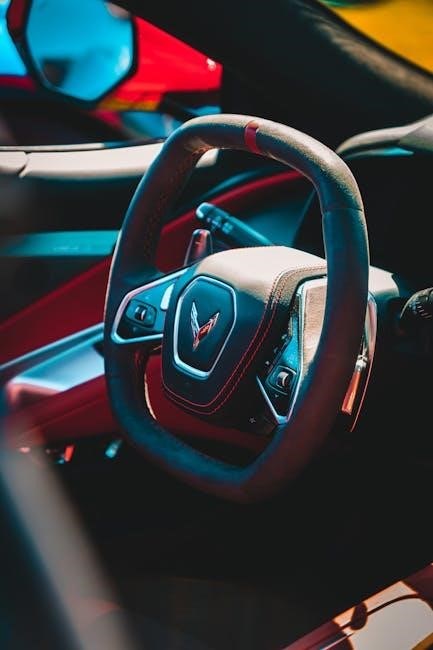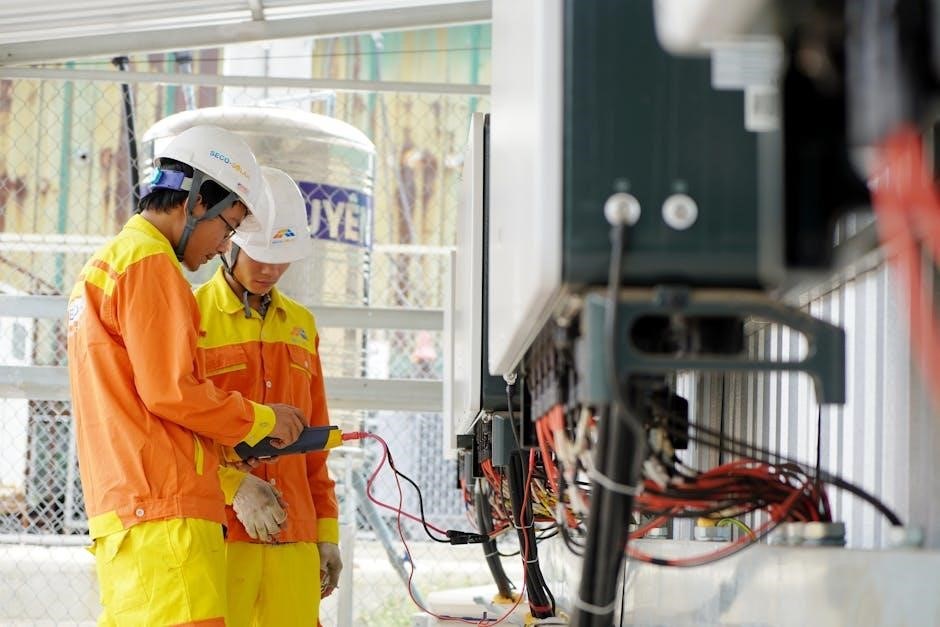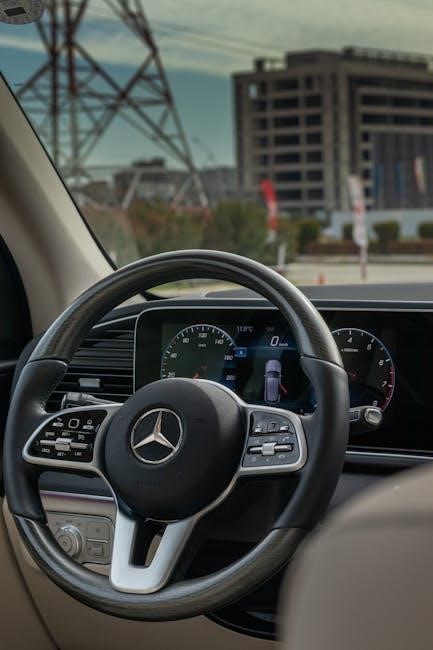power vs manual steering
Power steering and manual steering systems differ in mechanism and functionality. Power steering uses hydraulic or electric assistance, while manual steering relies solely on driver effort. This section introduces both systems, comparing their pros, cons, and driving experiences.
1.1 Overview of Steering Systems
Steering systems are categorized into power and manual types. Power steering uses hydraulic or electric assistance to reduce effort, enhancing maneuverability. Manual steering relies on driver input, providing direct road feedback. Both systems aim to facilitate vehicle control but differ in complexity, effort required, and driving experience. Understanding their mechanics is essential for comparison.
1.2 Historical Background and Evolution
Manual steering originated with early vehicles, requiring significant physical effort. Power steering emerged in the 1950s, introducing hydraulic assistance for easier control. Modern systems now incorporate electric power steering, offering improved efficiency and reduced weight. This evolution reflects advancements in automotive technology, enhancing driver comfort and vehicle maneuverability over time.

Key Differences Between Power and Manual Steering
Power steering uses hydraulic or electric assistance, reducing effort, while manual steering relies on driver strength. Power steering offers easier maneuverability but may lack road feedback compared to manual systems.
2.1 Mechanical Components and Functionality
Power steering systems incorporate hydraulic pumps, motors, and sensors, providing assisted turning. Manual steering relies on a straightforward gear-and-pinion or rack-and-pinion mechanism, requiring direct driver input without external assistance. These differences significantly impact handling and driver effort.
2.2 Steering Ratio and Responsiveness
Power steering systems often feature variable steering ratios, adjusting effort based on speed for easier maneuverability. Manual steering offers a fixed ratio, providing consistent responsiveness and direct road feedback. Power steering enhances low-speed agility, while manual steering delivers precise control at higher speeds, catering to different driving preferences and conditions.
2.3 Driver Input and Effort Required
Power steering reduces physical effort, making maneuvering easier, especially at low speeds. Manual steering demands more muscle, requiring consistent input and strength, particularly in tight spaces. Power steering enhances comfort, while manual systems provide direct feedback, engaging the driver more intimately with the road and vehicle dynamics.

Advantages of Power Steering
Power steering significantly reduces physical effort, making maneuvering easier, especially at low speeds. Manual steering demands more strength and input, engaging the driver more directly with the vehicle’s movement and road feedback.
3.1 Ease of Maneuverability
Power steering enhances maneuverability, especially in tight spaces and low-speed situations. It reduces effort, making tasks like parking or U-turns easier. Hydraulic or electric assistance allows smoother and quicker steering, improving overall driving convenience and reducing fatigue in urban environments compared to manual steering.
3.2 Reduced Driver Fatigue
Power steering significantly reduces driver fatigue by minimizing physical effort, especially during long drives or in heavy traffic. Hydraulic or electric assistance eases steering, lowering strain on the driver’s arms and shoulders, leading to a more comfortable and less tiring driving experience compared to manual steering.
3.4 Compatibility with Modern Vehicles
Power steering is seamlessly integrated into modern vehicles, enhancing their performance and appeal. Its compatibility with advanced systems, such as stability control and driver-assistance features, makes it indispensable for contemporary automotive designs. This integration ensures a smooth, responsive driving experience tailored to today’s demanding road conditions and technological advancements.

Disadvantages of Power Steering
Power steering systems are more complex, expensive, and reliant on auxiliary systems like hydraulics or electronics, which can fail and require costly repairs or maintenance.
4.1 Loss of Road Feedback
Power steering systems often reduce road feedback, making it harder for drivers to feel the road surface and vehicle behavior. This can diminish driver engagement and control, especially in dynamic driving conditions, compared to manual steering, which provides more direct connectivity to the road.
4.2 Increased Cost and Complexity
Power steering systems are more expensive to install and maintain due to their complex components, such as hydraulic pumps, motors, and control units. This complexity also increases the likelihood of mechanical failures, adding to overall vehicle costs compared to simpler manual steering setups.
4.3 Dependence on Auxiliary Systems

Power steering systems rely on auxiliary components like hydraulic pumps, electric motors, and control units, which depend on the vehicle’s energy sources. Failures in these systems can disable power steering, increasing the risk of losing control, especially at low speeds or during emergencies, unlike manual steering, which remains functional without auxiliary support.

Advantages of Manual Steering
Manual steering delivers better road feedback and precise control. Its simplicity ensures reliability without complex components, offering a more engaging and connected driving experience preferred by driving enthusiasts.
5.1 Enhanced Steering Feel and Precision
Manual steering provides direct feedback from the road, allowing drivers to feel every nuance. This precision enhances control, making it easier to navigate corners and maintain directional accuracy. The absence of power assistance ensures a more authentic connection between the driver and the vehicle’s handling dynamics.
5.2 Simplicity and Reliability
Manual steering systems are mechanically simpler, with fewer components, reducing the risk of failure. They require no auxiliary power, making them highly reliable and easier to maintain. This straightforward design ensures consistent performance without the complexity or potential malfunctions associated with power-assisted systems.
5.4 Better Connectivity with the Road
Manual steering provides a more direct connection to the road, offering enhanced tactile feedback. Drivers can feel the texture, resistance, and nuances of the road surface, which improves control and responsiveness. This heightened sense of connectivity fosters a more engaging and precise driving experience, especially for enthusiasts seeking a closer bond with their vehicle.

Disadvantages of Manual Steering
Manual steering demands more physical effort, especially in tight spaces or during low-speed maneuvers. It can be tiring on long drives and lacks modern convenience features.

6.1 Increased Physical Effort
Manual steering requires significantly more physical effort, especially during low-speed maneuvers or parking. Drivers must rely solely on muscle power, which can lead to fatigue and strain, particularly on long drives or in heavy traffic conditions.
6.2 Limited Maneuverability in Tight Spaces
Manual steering can be challenging in tight spaces due to the lack of assistance, making parking and U-turns more difficult. This requires precise driver input and additional effort, which can be frustrating in urban environments where agility is crucial.
6.3 Less Common in Modern Vehicles
Manual steering has become less common in modern vehicles due to the widespread adoption of power steering systems. While still valued in niche markets, such as classic cars or performance vehicles, manual systems are no longer the standard in contemporary automotive design.

Cost Considerations
Power steering systems generally have higher upfront costs due to additional components like hydraulic pumps and electronics. Manual steering, while simpler, may incur hidden costs over time, such as increased wear.
7.1 Upfront Costs of Power Steering
Power steering systems typically have higher initial costs due to the complexity of components like hydraulic pumps, motors, and sensors. These systems require additional installation and setup, increasing the overall expense compared to manual steering. The advanced technology and auxiliary systems drive up the upfront investment for power steering.
7.2 Maintenance and Repair Expenses
Maintenance and repair costs for power steering systems are generally higher due to their complex components. Hydraulic leaks, pump failures, and electronic malfunctions require specialized tools and expertise, driving up expenses. In contrast, manual steering systems have fewer parts and simpler mechanisms, resulting in lower maintenance and repair costs over time.
7.3 Long-Term Savings with Manual Steering
Manual steering systems often yield long-term savings due to their simplicity and fewer components. With less risk of breakdowns and lower repair costs, manual steering offers financial benefits over time, especially for drivers prioritizing reliability and minimal maintenance expenses.

Maintenance and Repair
Power steering systems require more frequent maintenance and can be costly to repair due to their complex components. Manual steering, being simpler, generally needs less upkeep and is more affordable to fix.
8.1 Ease of Maintenance for Manual Steering
Manual steering systems are simpler and more straightforward to maintain due to fewer components. They lack power assistance, reducing the need for complex repairs. Servicing is less frequent, and the system’s reliability makes it easier to upkeep compared to power steering.
8.2 Complexity of Power Steering Repairs
Power steering systems involve intricate components like hydraulic pumps, motors, and sensors, making repairs more complex. Specialized tools and expertise are often required, increasing costs and time. Additionally, diagnosing issues can be challenging due to the interconnected nature of these systems compared to manual steering.
8.3 Frequency of Servicing Needs
Power steering systems require regular fluid checks and potential replacements, while manual steering needs less maintenance. Power steering components like pumps and motors may demand frequent inspections, unlike manual systems. This difference in servicing frequency highlights the trade-offs between convenience and upkeep for each steering type.
Driving Experience and Handling
Manual steering offers enhanced road feedback and precision, appealing to driving enthusiasts, while power steering provides ease of maneuverability, making it ideal for everyday driving and tight spaces.
9.1 Steering Feel and Driver Engagement
Manual steering delivers direct road feedback, enhancing driver engagement and precision, while power steering prioritizes comfort, reducing effort but sometimes compromising on tactile connection with the road, affecting handling dynamics.
9.2 Precision and Control in Different Conditions
Manual steering offers precise control and feedback, excelling in dynamic driving conditions like track use or winding roads. Power steering, while less tactile, enhances stability and ease in high-speed or adverse weather conditions, improving safety and comfort for everyday driving scenarios.
9.4 Impact on Overall Vehicle Performance
Power steering enhances comfort and ease, reducing driver fatigue, while manual steering delivers superior road feel and responsiveness. The choice between them significantly impacts overall vehicle performance, balancing convenience and driver engagement based on specific driving needs and preferences.
Ultimately, the choice between power and manual steering depends on driving style and conditions. Power steering offers ease and comfort, while manual provides precision and control. Consider your needs and preferences when deciding.
10.1 Summary of Key Points
Power steering offers ease and comfort, reducing driver effort, while manual steering provides enhanced road feedback and precision. Driver preferences, vehicle type, and driving conditions are key factors in choosing between the two systems. Modern vehicles predominantly use power steering, but manual systems remain popular for specific driving scenarios and enthusiast preferences.
10.2 Choosing the Right Steering System
Choosing between power and manual steering depends on your priorities: ease of use or precise control. Select power steering for comfort and reduced effort, especially in urban driving, while manual steering suits those seeking direct road feedback and handling precision in performance or off-road scenarios.
10.3 Future Trends in Steering Technology
Future trends include advancements like electric power steering (EPS) systems, autonomous driving technologies, and steer-by-wire systems. These innovations aim to enhance safety, efficiency, and comfort. Integration of AI and machine learning will further personalize steering responses, offering drivers a seamless and adaptive driving experience.
Leave a Reply